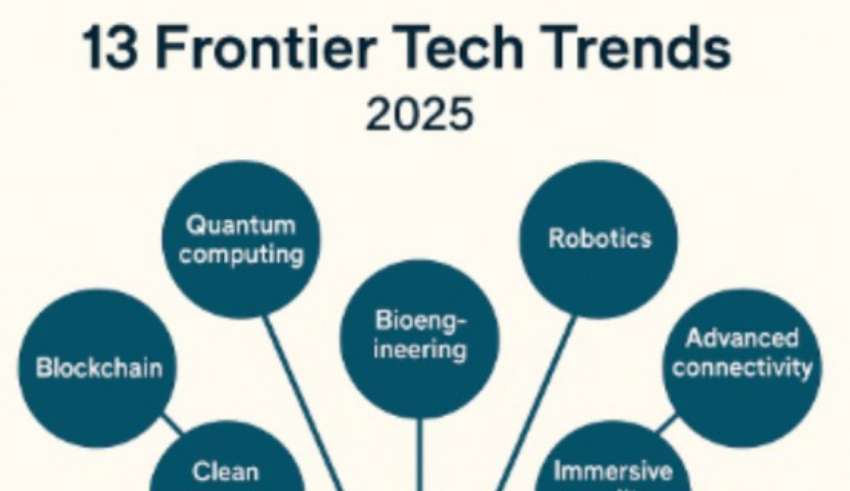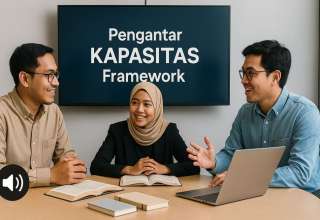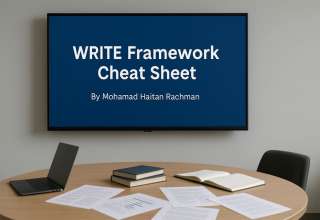
*) Gambar sebagai ilustrasi
Explanation of “13 Frontier Tech Trends 2025” with the SKILLS Framework
The image shows that Artificial Intelligence (AI) sits at the center of 13 frontier technologies for 2025: quantum computing, robotics, advanced connectivity (5G/6G), immersive reality (AR/VR/MR), cloud & edge computing, cybersecurity, blockchain, bio-engineering, clean energy systems, climate technologies, sustainable consumption & production, talent ecosystems, with sustainability as the overarching goal.
It means AI will accelerate and be accelerated by all of these, and everything requires structured skills management. Below is the step-by-step application of the SKILLS Framework: Scan – Know the Gaps – Improve – Leverage – Link – Sustain developed by Mohamad Haitan Rachman
S — Scan (Identify & Map Current Skills)
Goal: build a 360° visibility of “who can do what” across all trends.
What to scan?
- AI core: data literacy, statistics, machine learning, prompt engineering, MLOps, AI ethics.
- Cloud & Edge: cloud architecture, Kubernetes, IoT/edge devices, data pipelines.
- Cybersecurity: secure coding, IAM, incident response, privacy-by-design.
- Advanced connectivity: 5G/6G, network slicing, IoT protocols.
- Immersive reality: Unity/Unreal, 3D asset pipelines, immersive UX.
- Robotics/automation: robotics control, ROS, computer vision, sensor fusion.
- Quantum (basic): qubit concepts, simple algorithms, quantum simulation.
- Blockchain/Web3: smart contracts, tokenization, traceability.
- Bio-engineering (literacy): bio-data, ethics, AI integration in bioscience.
- Clean energy & climate tech: energy analytics, digital twins, carbon accounting.
- Sustainability & SCP: lifecycle analysis, circular design, ESG data.
- Talent ecosystems: mentoring, instructional design, knowledge community building.
Practical steps:
- Collect data from CVs, employee profiles, project portfolios, certificates, Git repos, and documentation.
- Build a skills taxonomy (200–400 priority skills) and a skills graph linking people–skills–roles–projects.
- Validate with evidence: project artifacts, assessments, peer/manager reviews.
Output: skills matrix per division, heatmap of competencies, coverage and freshness levels.
K — Know the Gaps (Identify Critical Skill Gaps & Priorities)
Goal: determine today’s and tomorrow’s gaps (6–24 months ahead).
Steps:
- Role-to-skill mapping: e.g. AI Product Manager → AI literacy, data sense, discovery, ethics, experiment design.
- Demand vs supply: compare current skills (supply) with roadmap needs (demand).
- Risk scoring: impact × likelihood (e.g., lack of “secure MLOps” = high risk for AI production projects).
- Local context scenario: manufacturing + robotics, edtech + immersive learning, green energy + AI monitoring.
Output: Top-10 gaps per unit (e.g., data engineering, AI safety, 5G IoT), plus build–buy–borrow strategy (upskill, hire, or collaborate).
I — Improve (Upskill–Reskill–Cross-skill)
Goal: close the gaps with targeted, evidence-based learning.
Steps:
- Adaptive learning paths: microlearning (statistics, Python), practical labs (ETL, model building), AR/VR simulations, security labs.
- Mentoring & buddy system: match mentor–mentee using the skills graph.
- Project-based assessments: mini-projects (carbon dashboard, predictive maintenance), code reviews, demo days.
- Micro-credentials/badges: tied to role readiness (e.g., “Edge AI Level-1 → ready for IoT projects”).
- Cross-skilling packages: UX for AI, ethics for data scientists, business strategy for engineers.
Targets: reduce time-to-competency, achieve ≥20% skill uplift, ≥85% learning completion rate.
L — Leverage (Deploy Skills for Maximum Value)
Goal: place the right people into the right projects using verified skills.
Quick win examples:
- AI + Cloud: automated KPI reporting → saves 20–30% staff time.
- Cybersecurity basics: a 6-week secure coding program reduces vulnerabilities.
- Immersive learning in vocational schools: AR/VR modules for machine operators.
- IoT & Edge in manufacturing: predictive maintenance and quality monitoring.
- Blockchain traceability for SMEs: transparent supply chain systems.
- Climate & sustainability: AI dashboards for carbon footprints and ESG reporting.
Talent marketplace: post “internal gigs” → AI recommends employees based on their skills + evidence.
Metrics: higher internal fill-rate, reduced bench time, better project velocity & quality.
L — Link (Connect Skills to KPIs, Careers, & Strategy)
Goal: ensure skills investment leads to measurable outcomes.
Steps:
- Integrate skills into OKRs & Balanced Scorecards (e.g., % of devs with “secure MLOps advanced” → reduced incidents).
- Career & compensation: skills-based grades and T-shaped career paths (specialist + generalist).
- Integrate with other Negeri Frameworks:
- KE3: knowledge → skills → value (explore–enrich–exploit).
- TALENT: Trace–Align–Learn–Express–Nurture–Transform executed via skills mapping.
- PERFORM: Plan–Execute–Reflect measured by skills uplift.
- SCORE: Specific–Clear–Outcome-based–Realistic–Evaluated for goal setting.
Metrics: ROI of L&D, contributions to NPS, time-to-market, reduced defects, and lower emissions.
S — Sustain (Keep Skills Relevant & Trusted)
Goal: prevent skills from becoming obsolete and ensure governance.
Foundations:
- Skill half-life tracking: refresh cycles (6–18 months depending on domain).
- Communities of Practice: monthly show-and-tell, shared best practices.
- AI governance & ethics: privacy, fairness, bias audits; human-in-the-loop for critical decisions.
- Templates & scale-out: rollout playbooks across units, partnerships with universities/SMKs/SMEs.
Metrics: reskilling rate ≥15%/year, low bias incidents, high community participation.
Practical 90-Day Roadmap
Days 0–30 (Foundation):
- Define pilot use case (e.g., AI reporting + basic cybersecurity in one division).
- Build a 250-skill taxonomy, collect CVs and portfolios.
- Run AI-driven scan + validation → publish heatmap & Top-10 skill gaps.
Days 31–60 (Build):
- Launch 3 learning tracks (AI basics, cloud pipelines, secure coding).
- Pilot talent marketplace for 2–3 projects.
- Dashboard metrics: coverage, gaps, time-to-skill, fill-rate.
Days 61–90 (Link & Scale):
- Tie skills to OKRs/KPIs; report early impacts (e.g., reporting time cut by 40%).
- Formalize governance & annual reskilling plan.
- Plan expansion into new domains (immersive, IoT, sustainability).
Risks & Mitigations
- Privacy: minimize personal data, role-based access control.
- Bias: diversify datasets, fairness testing, human reviews.
- Skill inflation: require evidence for each skill claim.
- Over-automation: AI as co-pilot; humans retain decision authority.
- Vendor lock-in: store taxonomies in open formats, prepare exit plans.
Skills Mapping per Trend (Examples)
- AI: ML basics, MLOps, ethics.
- Cloud/Edge: container orchestration, IoT integration.
- Cybersecurity: IAM, threat modeling, incident ops.
- Connectivity: 5G, device management.
- Immersive: Unity/Unreal, multimodal interaction.
- Robotics: ROS, vision systems, safety protocols.
- Quantum (literacy): qubit concepts, simulation tools.
- Blockchain: smart contracts, audit trail.
- Bio-engineering (literacy): bio-data, ethics.
- Clean energy & climate: sensors, digital twins, lifecycle analysis.
- SCP (sustainable consumption & production): circular design, traceability.
- Talent ecosystems: mentoring, coaching, curriculum design.
- Sustainability (umbrella): ESG data, reporting, governance.
In Summary
The chart “13 Frontier Tech Trends 2025” shows that AI is the driver of all other trends, and sustainability is the ultimate goal. To be ready, organizations must apply SKILLS:
- Scan skill inventories,
- Know critical gaps,
- Improve with evidence-based learning,
- Leverage for staffing & projects,
- Link to business KPIs and careers,
- Sustain through governance and continuous learning.
When executed systematically, companies, schools, and regions will accelerate innovation in smart manufacturing, immersive education, clean energy, and beyond.


